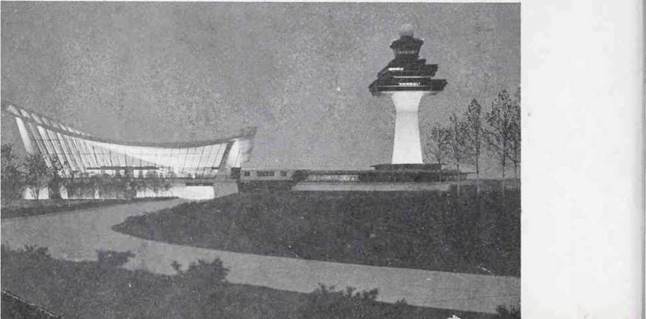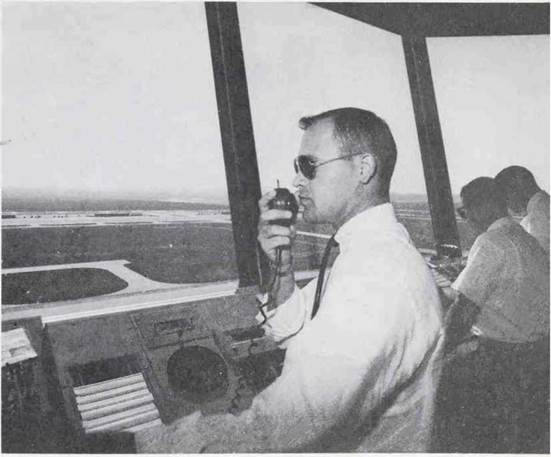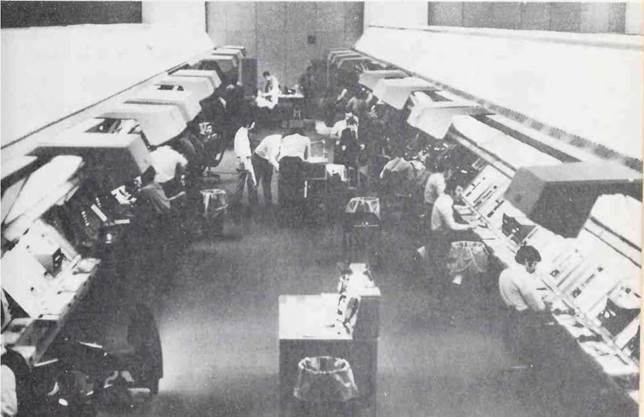AIR SAFETY
The control tower—standing high above all the other buildings—is an important center of activity at any airport. Rising 177 feet from airfield level, the control tower at Dulles International Airport—shown in the photo below— consists of a concrete shaft. Two stories in the upper section are used for radar and electronic equipment. The glass-enclosed room on top of the tower is called the cab.
 |
Workers in the tower are called air-traffic controllers. It is their job to direct planes in and around the airport. Large panes of glass in the cab give air-traffic controllers an unobstructed view of the runways and field. The controller in the cab—shown in the photo on page 25—is giving directions to a pilot by radio. He is telling the pilot which runway to use.
 |
An air-traffc controller clears the pilot for takeoff. The pilot heads the plane down the runway and into the wind. The engines roar as they thrust the plane forward. Slowly the air flowing past the wings lifts the plane from the ground. Then the pilot points the nose up to gain altitude.
A controller in the tower notes the time the plane took off. This information is sent to the Air Route Traffic Control Center in the area. There are twenty-one centers across the United States.
Each Air Traffic Control Center has a layout that is similar to the one shown in the photo on page 27. It is the job of the controllers at these centers to keep track of a plane from its takeoff to its landing. The controller shown in the photo on page 26 is using equipment that electronically writes an aircraft’s altitude and identity on the radar dis – p! ay.
|
|
The fundamental element in air-traffic control is separation. This means that aircraft are separated laterally, longitudinally, and vertically. The lateral or side-by-side separation is maintained by routing aircraft over several parallel airways. The longitudinal or lengthwise separation on an airway is maintained by having a minimum flying time of ten minutes between an aircraft and the one following. Vertical separation is achieved by assigning different altitudes to aircraft on the same airway.
Below 18,000 feet, an aircraft on a heading between о degrees and 179 degrees is assigned an odd thousand-foot altitude. For example, an airplane flying eastward on a heading of 90 degrees may be assigned to an altitude of
5,0 feet. On the other hand, an aircraft flying on a heading of 180 degrees to 359 degrees is assigned an even thousand-foot altitude. This means that a plane moving
westward on a heading of 270 degrees could be assigned an altitude of 6,000 feet.
Above 18,000 feet, the same system of odd and even thousand-foot altitude assignments is used. The assigned altitudes above 18,000 feet are called flight levels, however. An altitude of 19,000 feet is referred to as Flight Level 190. An aircraft flying at 29,000 feet is at Flight Level 290.

Two sets of rules control the movement of all aircraft in the United States. These federal regulations are known as Visual Flight Rules (VFR) and Instrument Flight Rules (IFR). VFR means that the earth’s surface is clearly visible and the pilot can fly the plane by referring to landmarks. When visibility is poor and weather conditions are producing problems, the pilot controls and directs the aircraft by referring to instruments within the cockpit. Under these conditions, the pilot uses IFR. The prevailing weather over most of the United States and the need to fly along designated airways limit VFR flying.











